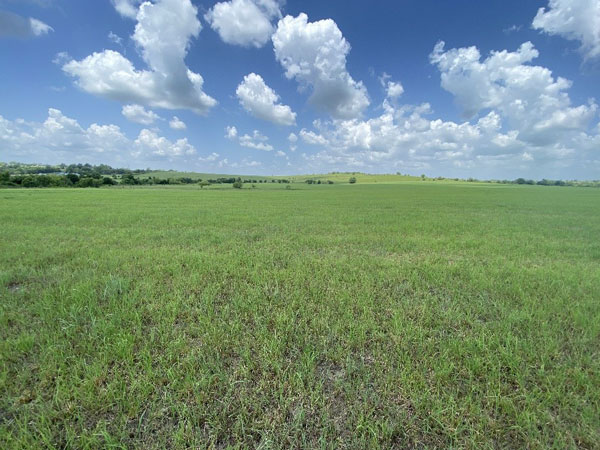Establishment is the most important phase to ensure system longevity when planning the long-term use of a seeded native grass stand. Native species are slow to establish and do not compete well with other plants (weeds). For this reason, native grass pastures can take up to four years to become fully established. Because they have been selected for better establishment and forage production characteristics, use known cultivars. Species and cultivar selection, site preparation, seed quality, seed source, and seeding date must be considered to ensure the successful establishment of a native grass pasture. Planning is the key to achieving a successful stand (Figure 1).

Figure 1. Well-established native prairie. Photo by Bruno Pedreira, K-State Research and Extension.
Before seeding
Before seeding, it is important to assess resources, including soil type, fertility, and current and past cropping uses, and how these resources affect the establishment of new native pasture. Producers must understand the potential challenges (existing weed problems, seed bank, and potential cropland herbicide carry-over), necessary changes in the farming operation, available equipment, seed sources, the intended use of the seeded area, costs and returns anticipated, and suitability for wildlife habitat. This information contributes to the preparation for seeding.
Soils
The first step in knowing the potential yield for haying or grazing is to understand more about the soil. Soil texture can be identified by a lab test or by searching NRCS soil survey maps, available through the NRCS Web Soil Survey (websoilsurvey.nrcs.usda.gov).
Additionally, soil chemical properties needs to be determined. Previous cropping history, particularly herbicide use, is necessary to prevent seedling damage from herbicide carryover. Seedling damage can result from long-residual herbicides, particularly those used for grass control. Short-residual herbicides are less likely to injure seedlings. Herbicides with rotation restrictions for corn or grain sorghum are an indication of potential seedling damage. Check labels for plant-back intervals and expected suppression.
The species and cultivar selected should be adapted to the field’s soil. If several different soils occur in a field, splitting the field should be considered, and changes in seedbed preparation may be required.
Seedbed preparation
A firm, weed-free seedbed is recommended. Seedbed preparation depends on climate, soils, and intended use. In most cases, clean-tilled seedbeds are preferred to establish pastures, especially where precipitation is greater than 32 inches per year. The seedbed is tilled as needed to destroy all weeds and leave a firm, friable seedbed. Weed control is a major requirement for a successful stand. The use of a cultipacker or similar equipment before and/or after seeding can greatly improve the stand of grass, especially during seasons of low rainfall. This approach stores soil moisture but requires precipitation after seeding to ensure a successful stand.
More information on no-till seedbeds can be found at bookstore.ksre.ksu.edu/pubs/MF2291.pdf .
Seeding method
Proper seeding depth is important to obtain adequate establishment of native grasses. Most seeds cannot emerge from deeper than 1/2 to 1 inch. Grass drills will handle the fluffy seed of most native grass species and ensure accurate placement, delivering the seed at a uniform rate.
Origin and quality of seed
Companies selling certified seed are required by law to inform buyers of seed quality. This allows buyers to determine the amount of seed to plant. Native grass seed quality is measured on a pure-live-seed (PLS) basis, which is calculated based on germination and purity. See details and examples at bookstore.ksre.ksu.edu/pubs/MF2291.pdf
Seeding rates
Seeding rates vary by soil, precipitation, and intended use of the seeding. For help on seeding rates and mixtures, consult the county Natural Resource Conservation Service Office, local K-State Research and Extension office, wildlife agencies, or seed dealers. An example mixture is given at bookstore.ksre.ksu.edu/pubs/MF2291.pdf.
Seeding dates
Recommended planting dates are based on research, but they may be adjusted for your region based on local knowledge. For warm-season grasses, the optimum seeding date is about 2 weeks before the average last frost date and at least 6 weeks before hot, dry summer weather (Figure 2). If it is not possible, 1 month before to 3 weeks after the average last frost date may be an acceptable period for seeding. This allows the seedling 6 to 8 weeks to establish the permanent root system before hot, dry summer weather.
Fertilization
In drier climates of Kansas, fertilizer and lime are not normally required for native species at seeding. Lime is suggested if the pH is below 6.0. Taking soil samples contributes to successful seeding. Consult NRCS or local K-State Research and Extension personnel for local needs. Fertilizing may stimulate weed competition during the establishment phase.

Figure 2. Optimum and acceptable seeding dates for native grass species.
This article originated from the recently released KSRE publication Establishing Native Grasses (MF2291) and can be viewed online at bookstore.ksre.ksu.edu/pubs/MF2291.pdf.
More information on factors to consider during and after stand establishment can be found in the aforementioned publication and in a companion article to be published in the next eUpdate.
Bruno Pedreira, Area Agronomist - Parsons
pedreira@ksu.edu
Walt Fick, Range Management Specialist
whfick@ksu.edu
Tags: rangeland native grasses